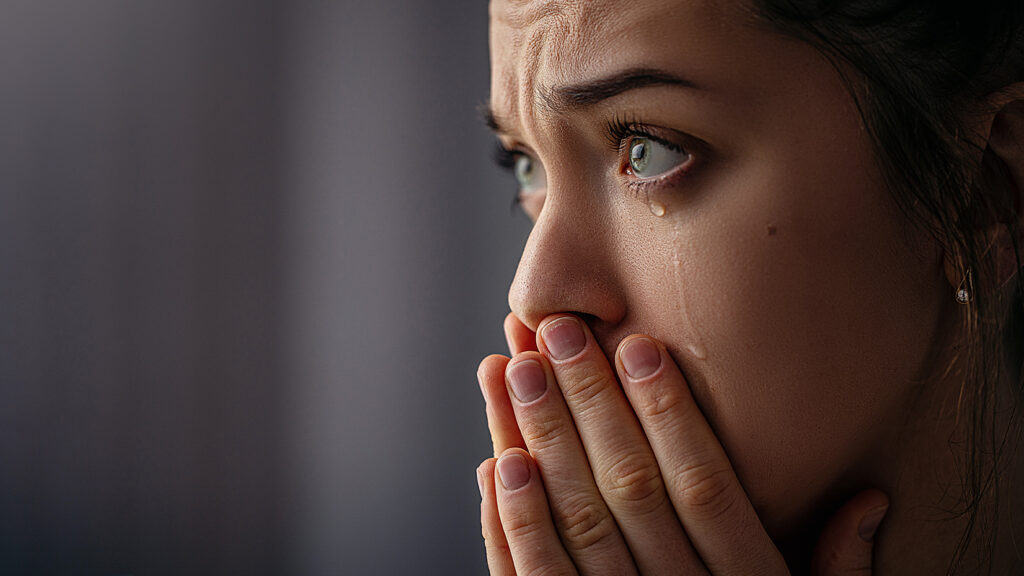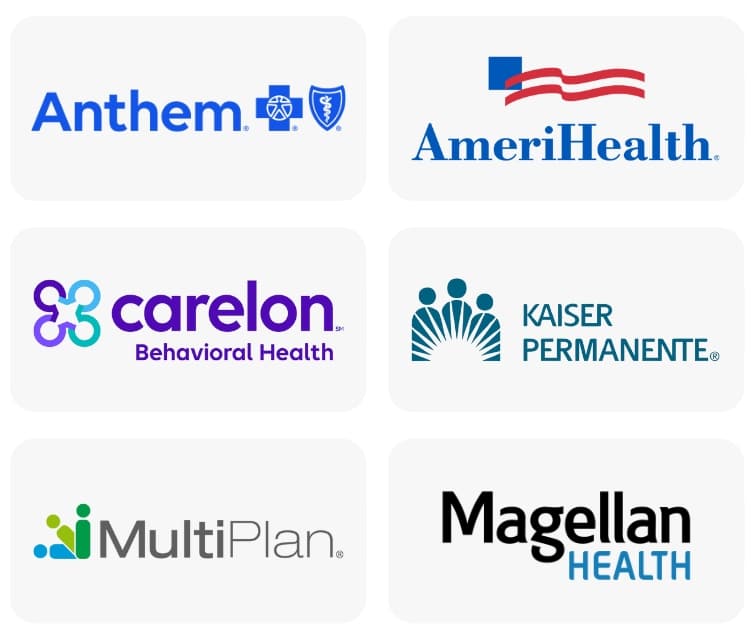Skip To Section
Everyone feels anxiety. When things like work or family problems cause stress or overwhelm, our bodies respond physically and mentally. Anxiety is normal when it happens from time to time, but if you experience it all the time, you may be suffering from an anxiety disorder. Footprints to Recovery offers generalized anxiety disorder (GAD) treatment to help.
Generalized anxiety disorder is one ailment that makes living daily life challenging. Those who suffer from it feel persistent fear or dread that will not go away. Some turn to self-medicating with drugs and alcohol to feel better. The escape provided by getting drunk or high can lead to substance use disorders.
To prevent anxiety from taking over your life, it’s important to get GAD treatment from professional and certified therapists. Footprints to Recovery assists people with anxiety disorders—and those with addiction issues—in turning their lives around. Using research-based programs, the team at Footprints to Recovery can help you get your generalized anxiety under control.

What Is Generalized Anxiety Disorder?
GAD is a mental health condition that causes persistent and excessive anxiety, worry, and fear. People with GAD may feel anxious about a variety of things, such as their job, school, family life, or other daily activities. These negative feelings take hold during situations where there’s no real danger or threat.
This disorder develops over time. Most people receive a diagnosis in adulthood. Symptoms may be mild to start but grow more intense as time passes. Unlike a panic disorder, GAD doesn’t usually cause severe panic attacks. Anxiety is more constant and underlying rather than severe and acute.
According to data from the International Socioeconomics Laboratory, around 3% of adults in the United States suffer from GAD. Only 43% of those people get help for their anxiety.
What Are the Symptoms of GAD?
Symptoms of generalized anxiety disorder make life a challenge for those who live with them. What makes dealing with GAD so difficult is that symptoms arise in normal interactions or situations.
Psychological GAD symptoms include:
- Restlessness or feeling on edge
- Difficulty concentrating
- Feelings of apprehension or dread
- Irritability
Many people with GAD also experience physical symptoms such as:
- Fatigue
- Headaches
- Stomach aches and nausea
- Hot flashes
- Muscle tension
- Sweating
- Trembling
- Difficulty concentrating
- High blood pressure
Some may even have trouble sleeping or breathing during intense feelings of anxiety. And because GAD can cause high blood pressure, they’re at an increased risk of heart attack.
How Is GAD Diagnosed?
Diagnosing a condition like generalized anxiety disorder in adults can be challenging since the symptoms are similar to other mental health issues like depression or bipolar disorder. GAD must be diagnosed by a mental health professional, like those at Footprints to Recovery. They diagnose GAD by doing an evaluation of symptoms, both physical and mental. This evaluation may include gathering information about your medical and family history and your current physical and emotional state. The clinician also usually asks questions about the frequency, the severity, and the length of time GAD symptoms persist.
To reach a diagnosis of GAD, clinicians use the Diagnostic and Statistical Manual of Mental Disorders Fifth Edition (DSM-5). patients must experience excessive anxiety for at least six months that is not due to substance use or another medical condition. The following factors are necessary for a diagnosis of generalized anxiety disorder:
- At least six months where excessive worry or anxiety occurs almost daily
- An inability to control worrying
- Problems functioning at work or in school
People with GAD also experience at least three of the following symptoms:
- Fatigue
- Issues with concentration
- Bad attitude
- Tense muscles
- Trouble falling asleep
- Restless behavior
It’s also important for clinicians to identify that you’re not suffering from any of the above due to a substance abuse disorder or any other anxiety or panic disorder. As mentioned above, symptoms of other anxiety disorders tend to be like GAD, making it more difficult to diagnose.
What Causes Generalized Anxiety Disorder?
The exact cause of GAD isn’t known. Someone with a family history of anxiety disorders is more likely to develop the issue, as are those with a history of trauma. Other factors that may contribute to GAD include:
- Periods of high stress
- Prolonged substance abuse
- Suffering from other mental health issues like depression

Generalized Anxiety Disorder and Addiction
Research on the subject has shown a definitive link between anxiety and addiction. Statistics show that around 20% of Americans who suffer from an anxiety or mood disorder also have an issue with substance abuse. The reverse is also true: About 20% of American with an alcohol or substance use disorder also have an anxiety or mood disorder.
When the symptoms of anxiety grow worse, some people turn to drugs and alcohol to self-medicate. While this might make the symptoms of anxiety feel better in the very short term, over the long term, it makes them worse and create a terrible cycle of addiction perpetuating mental health issues. The longer addiction and mental illness are left unchecked, the more challenging it can be to overcome them. People with anxiety disorders may experience significant withdrawal symptoms when they try to detox from drugs and alcohol due to their heavy, prolonged use.
The process used to treat co-occurring mental health and substance abuse is known as dual diagnosis treatment. It recognizes that these conditions are connected and provides comprehensive care to people facing both challenges. Treating addiction and mental health at the same time is crucial for an effective recovery. Dual diagnosis is a valuable treatment technique employed throughout your journey to recovery.
What Does Professional GAD Treatment Look Like?
Anxiety disorders like GAD are treatable when you trust your recovery to a professional treatment center. Those who try to overcome mental illness on their own may find the process more difficult than they realized. A treatment center includes therapies, support, and guidance from clinical experts who understand anxiety disorders and how to treat them.
Some of the recovery programs for addiction and mental illness include:
- Medical detox program
- Residential treatment program
- Partial hospitalization program
- Intensive outpatient program
- Outpatient program
At Footprints to Recovery, our dual-diagnosis treatment centers offer a full continuum of treatment options for mental illness and addiction. A certified substance abuse counselor will assist you in devising a recovery plan that includes research-based and holistic treatment programs.
Medical Detox for Addiction and Anxiety
Ending substance abuse means stopping all usage, and it’s necessary for people dealing with the co-occurring disorders of GAD and addiction. Ridding the body of drugs and alcohol is the first step to living a sober life, this occurs in a medical detox program. Professional medical staff at Footprints to Recovery oversee the process so detox is safe and comfortable for each client. Your team of addiction therapists manages any complications that arise during detox so you can focus on your future.
Residential Treatment for Addiction and Anxiety
Residential treatment, also known as inpatient treatment, helps people with severe mental health disorders and co-occurring disorders. It uses research-based programs with the therapy techniques that are most likely to result in a mentally well future. These include group and individual therapy, family therapy, holistic programs, and medication-assisted treatment. You live full-time at a rehab center during residential treatment so you can focus all your energy on recovery.
Partial Hospitalization for Addiction and Anxiety
A partial hospitalization program (PHP) works for patients who need the structure of GAD treatment without 24-hour care and supervision. It’s a combination of inpatient and outpatient care that offers more flexibility in recovery. You are free to live at home, but you spend up to five days a week in treatment at the facility. It’s a first step towards independence for those in search of brighter futures.
Intensive Outpatient for Addiction and Anxiety
An intensive outpatient program (IOP) is another option that draws from elements of inpatient and outpatient rehab. patients usually visit the treatment facility three to five times weekly. Treatments include therapy and holistic programs but with a focus on taking the next step out into the world equipped with the tools and coping mechanisms necessary to handle generalized anxiety disorder.
Outpatient Treatment for Addiction and Anxiety
Outpatient rehab – Outpatient GAD treatment involves all aspects of the other levels of care. You don’t live at a treatment facility full-time and have fewer, shorter sessions. Outpatient rehab allows you to put to use the skills and coping mechanisms you’ve learned in GAD treatment.
Therapies for GAD Treatment
Treatment programs at Footprints to Recovery use research-based, proven methods to manage mental illness. Some of the most popular and effective therapies include:
- Cognitive behavioral therapy (CBT)
- Dialectical behavior therapy (DBT)
- Acceptance and commitment therapy (ACT)
By participating in these therapies, people struggling with generalized anxiety can learn to manage their symptoms and reduce the impact that it has on their daily lives.
It’s important to note that what works for one person may not work for another when it comes to managing anxiety. It may take some trial and error to find the right combination of therapy, medication (if prescribed), and lifestyle changes. It’s also crucial to seek professional help from a therapist or doctor if symptoms of anxiety are interfering with daily life.
CBT for Anxiety
Cognitive behavioral therapy (CBT) is an research-based psychotherapy effective in managing generalized anxiety disorder. CBT helps reduce anxiety symptoms by teaching you how to identify, challenge, and change your negative thoughts, beliefs, and behaviors.
Cognitive behavioral techniques include:
- Cognitive restructuring
- Exposure
- Behavioral activation
- Problem solving
- Values clarification
These therapeutic interventions can help you manage GAD in more effective ways and encourages you to develop coping skills to manage your stress. During cognitive behavioral therapy sessions, you work with a therapist to create specific goals for treatment. You also develop strategies for achieving those goals. The therapist may also provide education about GAD and its causes so you can better understand your condition.
DBT for Anxiety
Dialectical behavior therapy (DBT) is a type of therapy designed to help you cope with intense emotions. The goal is to teach you new skills to manage your emotions in more productive ways. DBT focuses on helping you become mindful of how you’re feeling in the moment. Teaching you how to accept and move forward with your emotions is a key component. You learn to:
- Identify your triggers
- Mindfulness exercises
- Understand the underlying causes of your worries
- Develop strategies for reducing anxiety levels
DBT skills training can help people with co-occurring anxiety improve their self-awareness and challenge false beliefs. It can also help improve relationships and communication skills. By learning these techniques, you can gain a better understanding of yourself and your emotions, which can lead to a more balanced and fulfilling life.
ACT for Anxiety
Acceptance and commitment therapy (ACT) encourages individuals to accept their anxious thoughts without judgment while also taking actions towards living a meaningful life. This therapy focuses on identifying personal values and using them as a guide for making decisions and taking action.
ACT strategies include mindfulness techniques, such as deep breathing and body scans, to help individuals become more aware of their current thoughts and feelings. It also involves facing fears through exposure therapy and developing coping skills to manage anxiety in difficult situations.
Medication for GAD
Medically assisted treatment for GAD – There are options for treating anxiety disorders with medication. They include anti-depressants and anti-anxiety medications. Only a doctor or behavioral health professional can determine if medically assisted treatment is right for you. Common medications for GAD can include:
- Xanax
- Zoloft
- Lexapro
- Celexa
Depending on your unique situation and body chemistry, one medication may work better for you than another. During treatment, our doctors regularly check in patients taking medications for GAD. This allows our team to monitor any changes in symptoms or side effects and make necessary adjustments.
Remember that everyone’s journey with GAD is unique, and finding the right combination of medication and therapy may take time. Be patient with yourself and trust the process.

Getting Help For Substance Abuse and Generalized Anxiety
Every GAD situation is unique. Finding a personalized recovery plan can make all the difference in improving your life. A consultation with a treatment center like Footprints to Recovery will help you determine which level of care to treat anxiety is best for you. Working with clinical care professionals offers the best chance at turning your life around. Contact the team today for a consultation and free insurance verification to see what GAD treatment options are available.
- Generalized anxiety disorder – Symptoms and causes – Mayo Clinic
- Socioeconomic and Health Care Demands of Anxiety Disorders
- Substance Use and Co-Occurring Mental Disorders – National Institute of Mental Health (NIMH)
- Substance Use Disorders | Anxiety and Depression Association of America, ADAA
- Generalized anxiety disorder – Diagnosis and treatment – Mayo Clinic
Our admissions team is available 24/7 to listen to your story and help you get started with the next steps.


